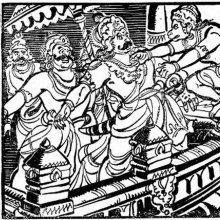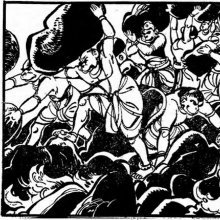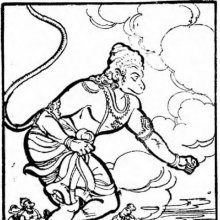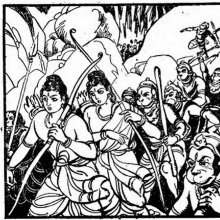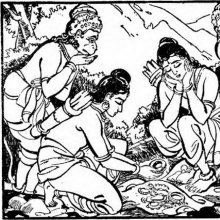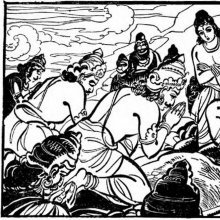Vanara, Vānara: 32 definitions
Introduction:
Vanara means something in Buddhism, Pali, Hinduism, Sanskrit, Jainism, Prakrit, the history of ancient India, Marathi, Hindi. If you want to know the exact meaning, history, etymology or English translation of this term then check out the descriptions on this page. Add your comment or reference to a book if you want to contribute to this summary article.
Images (photo gallery)
(+9 more images available)
In Hinduism
Purana and Itihasa (epic history)
Source: Google Books: Cultural History from the Vāyu PurānaVānara (वानर) falls under the category of wild beasts (āraṇya-paśu) according to the Vāyu Purāṇa.
Source: archive.org: Puranic EncyclopediaVānara (वानर).—(monkey) Monkeys are given a prominent place in the Purāṇas. Considering them as born in the family of Hanūmān, an ardent devotee of Śrī Rāma, some worship monkeys. It is mentioned in Vālmīki Rāmāyaṇa that the monkeys got a prominent place first among the gods and spirits. It is stated in Vālmīki Rāmāyaṇa, Kiṣkindhā Kāṇḍa, Sarga 33, that the leaders of the monkeys were Bāli, Sugrīva, Aṅgada, Mainda, Gavaya, Dvivida, Gavākṣa, Gaja, Śarabha, Sūryākṣa, Hanūmān, Vidyunmālī, Vīrabāhu, Subāhu, Nala, Kumuda, Jāmbavān, Tāra, Supāṭala, Sunetra, Nīla and Dadhivaktra.
The social life of the monkeys, is described as follows in the Vālmīki Rāmāyaṇa, Kiṣkindhā Kāṇḍa, Sarga 33. "Mahendra mountain, the Himālayas, the Vindhya mountain, the peaks of Kailāsa and Śveta mountain, Mandara mountain etc. are the places mostly inhabited by monkeys. On the mountains shining like the rising sun, on the east of the western ocean also monkeys live. The Monkeys which inhabit black soil are blue in colour. Monkeys which live in red arsenic caves are yellow in colour. Those which live in Mahā Meru and Dhūmra (smoky) mountain have the colour of the rising sun and are drunkards."
Source: archive.org: Shiva Purana - English TranslationVānara (वानर) refers to Monkeys (of which Hanumat is mentioned as the most important), according to the Śivapurāṇa 2.5.2 (“The Prayer of the gods).—Accordingly, as the Gods eulogized Śiva: “[...] Among all kindred beings you are Dharma. In all stages of life you are Sannyāsa. You are the supreme Liberation in all Vargas. Among Rudras you are Nīlalohita. Among all Ādityas you are Vāsudeva; among the monkeys you are Hanumat; among the sacrifices you are Japayajña; among the weapon-bearers you are Rāma. [...]”.
Source: Cologne Digital Sanskrit Dictionaries: The Purana IndexVānara (वानर).—(also Haris)—born of Harī and Pulaha: eleven groups distinguished: Dvīpins, Śarabhas, Simhas Vyāghras, Nīlas, Salyakas, Ṛkṣas, Mārjāras, Lohāsas, Vānaras, and Māyavas. Vāli was their Lord: Belong to the line of Krodhavaśa;1 should not see the Śrāddha food.2
Source: JatLand: List of Mahabharata people and placesVānara (वानर) is a name mentioned in the Mahābhārata (cf. I.60.7) and represents one of the many proper names used for people and places. Note: The Mahābhārata (mentioning Vānara) is a Sanskrit epic poem consisting of 100,000 ślokas (metrical verses) and is over 2000 years old.

The Purana (पुराण, purāṇas) refers to Sanskrit literature preserving ancient India’s vast cultural history, including historical legends, religious ceremonies, various arts and sciences. The eighteen mahapuranas total over 400,000 shlokas (metrical couplets) and date to at least several centuries BCE.
Ayurveda (science of life)
Dietetics and Culinary Art (such as household cooking)
Source: Shodhganga: Dietetics and culinary art in ancient and medieval IndiaVānara (वानर) refers to the “monkey” as described in the 17th century Bhojanakutūhala (dravyaguṇāguṇa-kathana), and is commonly found in literature dealing with the topics of dietetics and culinary art, also known as Pākaśāstra or Pākakalā.—Vānara is mentioned in a discusses regarding the reaction of certain insects and other living beings on consumption of poisionous food. The after-effect of intake of poison for Vānara (monkey) is defined as: “ śakṛnmuñcati (defecate)”.
Veterinary Medicine (The study and treatment of Animals)
Source: Shodhganga: Portrayal of Animal Kingdom (Tiryaks) in Epics An Analytical studyVānara (वानर) refers to the Common langur (Semnopithecus entellus), according to scientific texts such as the Mṛgapakṣiśāstra (Mriga-pakshi-shastra) or “the ancient Indian science of animals and birds” by Hamsadeva, containing the varieties and descriptions of the animals and birds seen in the Sanskrit Epics such as the Ramayana and Mahabharata.
Unclassified Ayurveda definitions
Source: Wisdom Library: Āyurveda and botanyVānara (वानर) is a Sanskrit word referring to the animal “monkey”. The meat of this animal is part of the māṃsavarga (‘group of flesh’), which is used throughout Ayurvedic literature. The animal Vānara is part of the sub-group named prasaha, refering to animals “who take their food by snatching”. It was classified by Caraka in his Carakasaṃhitā sūtrasthāna (chapter 27), a classical Ayurvedic work. Caraka defined such groups (vargas) based on the dietic properties of the substance.
Source: archive.org: Sushruta samhita, Volume IVānara (वानर)—Sanskrit word for an animal corresponding to “monkey”. This animal is from the group called Parṇa-mṛga (‘tree dwellers’ or ‘tree-dwelling arboreal animals’). Parṇa-mṛga itself is a sub-group of the group of animals known as Jāṅghala (living in high ground and in a jungle).

Āyurveda (आयुर्वेद, ayurveda) is a branch of Indian science dealing with medicine, herbalism, taxology, anatomy, surgery, alchemy and related topics. Traditional practice of Āyurveda in ancient India dates back to at least the first millenium BC. Literature is commonly written in Sanskrit using various poetic metres.
Natyashastra (theatrics and dramaturgy)
Source: archive.org: Natya ShastraVānara (वानर).—Description of a women of monkey (vānara) type;—A woman who has a compact and small body, is impudent, has tawny hairs, is fond of fruits, talkative, fickle, and energetic, loves trees, gardens and forests, cherishes highly even a small kind act done to her and forces sexual act, is said to have the nature of a monkey (vānara).

Natyashastra (नाट्यशास्त्र, nāṭyaśāstra) refers to both the ancient Indian tradition (shastra) of performing arts, (natya—theatrics, drama, dance, music), as well as the name of a Sanskrit work dealing with these subjects. It also teaches the rules for composing Dramatic plays (nataka), construction and performance of Theater, and Poetic works (kavya).
Chandas (prosody, study of Sanskrit metres)
Source: Shodhganga: a concise history of Sanskrit Chanda literatureVānara (वानर) refers to one of the 23 types of dohā metres (a part of mātrā type) described in the 1st chapter of the Vṛttamauktika by Candraśekhara (17th century): author of many metrical compositions and the son of Lakṣmīnātha Bhaṭṭa and Lopāmudrā.

Chandas (छन्दस्) refers to Sanskrit prosody and represents one of the six Vedangas (auxiliary disciplines belonging to the study of the Vedas). The science of prosody (chandas-shastra) focusses on the study of the poetic meters such as the commonly known twenty-six metres mentioned by Pingalas.
Dharmashastra (religious law)
Source: Prācyā: Animals and animal products as reflected in Smṛti textsVānara (वानर) refers to the animal “Common Langur” (Semnopithecus entellus).—The Smṛtis mention several domestic as well as wild animals that are enumerated in context of specifying expiation for killing them, the flesh being used as a dietary article to give satisfaction to the Manes (Pitṛs) in Śrāddha rites, the law of transmigration due to various sins committed as well as in the context of specifying gifts to be given on various occasions. These animals [viz., Vānara] are chiefly mentioned in the Manusmṛti, Parāśarasmṛti [Chap.6], Gautamasmṛti [17.2 and 15.1], Śātātapasmṛti [II.45-54], Uśānasmṛti [IX.7-9; IX.12-13], Yājñavalkyasmṛti [I.170-171; I.175; I.258- 260], Viṣṇusmṛti [51.3;51.6;51.26;51.33;80.3-14], Uttarāṅgirasasmṛti [X.15-17], Prajāpatismṛti [Śrāddhatyājyavastuvarṇanam. 138-143], 9 Kāśyapasmṛti [Section on Prāyaścittavarṇanam], Vṛddha Hārītasmṛti [6.253-255] and Kātyāyanasmṛti [27.11].

Dharmashastra (धर्मशास्त्र, dharmaśāstra) contains the instructions (shastra) regarding religious conduct of livelihood (dharma), ceremonies, jurisprudence (study of law) and more. It is categorized as smriti, an important and authoritative selection of books dealing with the Hindu lifestyle.
Shaivism (Shaiva philosophy)
Source: SOAS University of London: Protective Rites in the Netra TantraVānara (वानर) refers to a “(seeing) a monkey” (in dreams) , according to the Svacchanda-tantra.—Accordingly, [verse 4.21-27, while describing inauspicious dreams]—“[The dreamer] sees a bear or monkey (vānara—ṛkṣavānaradarśanam), demons, cruel beings, and dark men. [He sees those who] have erect hair, dirty ones, those who wear black garlands, clothes, and coverings. That man who, in his dream, embraces a red-eyed woman, he dies, there is no doubt, if he does not bring about peace. [...]”

Shaiva (शैव, śaiva) or Shaivism (śaivism) represents a tradition of Hinduism worshiping Shiva as the supreme being. Closely related to Shaktism, Shaiva literature includes a range of scriptures, including Tantras, while the root of this tradition may be traced back to the ancient Vedas.
In Buddhism
Mahayana (major branch of Buddhism)
Source: Wisdom Library: Maha Prajnaparamita SastraVānara (वानर) refers to a “long-tailed monkey” represents an incarnation destination of the tiryaggati (animal realm) according to the “world of transmigration” section in the 2nd century Mahāprajñāpāramitāśāstra (chapter XXVII).—The Bodhisattva sees the animals (tiryak) undergoing all the torments: they are made to gallop by blows of the whip or stick; they are made to make long journeys carrying burdens; their harness is damaged; they are branded with hot iron. As a result of greed (mātsarya), envy (īrṣyā), impulsiveness and haste, they take the form of [for example], a long-tailed monkey (vānara).

Mahayana (महायान, mahāyāna) is a major branch of Buddhism focusing on the path of a Bodhisattva (spiritual aspirants/ enlightened beings). Extant literature is vast and primarely composed in the Sanskrit language. There are many sūtras of which some of the earliest are the various Prajñāpāramitā sūtras.
Tibetan Buddhism (Vajrayana or tantric Buddhism)
Source: Wisdom Library: Tibetan BuddhismVānara (वानर) is the name of a Rāśi (zodiac sign) mentioned as attending the teachings in the 6th century Mañjuśrīmūlakalpa: one of the largest Kriyā Tantras devoted to Mañjuśrī (the Bodhisattva of wisdom) representing an encyclopedia of knowledge primarily concerned with ritualistic elements in Buddhism. The teachings in this text originate from Mañjuśrī and were taught to and by Buddha Śākyamuni in the presence of a large audience (including Vānara).

Tibetan Buddhism includes schools such as Nyingma, Kadampa, Kagyu and Gelug. Their primary canon of literature is divided in two broad categories: The Kangyur, which consists of Buddha’s words, and the Tengyur, which includes commentaries from various sources. Esotericism and tantra techniques (vajrayāna) are collected indepently.
In Jainism
General definition (in Jainism)
Source: archive.org: TrisastisalakapurusacaritraVānara (वानर) refers to the monkeys living on the Vānaradvīpa, according to the Jain Ramayana and chapter 7.1 [origin of the rākṣasavaṃśa and vānaravaṃśa] of Hemacandra’s 11th century Triṣaṣṭiśalākāpuruṣacaritra: an ancient Sanskrit epic poem narrating the history and legends of sixty-three illustrious persons in Jainism.
Accordingly, “[...] After [Śrīkaṇṭha] had founded his capital, named Kiṣkindhā, on Mt. Kiṣkindha on Vānaradvīpa, Kīrtidhavala installed him in his kingdom. King Śrīkaṇṭha saw many monkeys roving about on the island. They were handsome, with large bodies, and lived on fruit. He proclaimed that they should not be killed and had food, drink, etc. given them. Others, also treated them well. Like king, like subjects. From that time on for amusement the Vidyādharas made monkeys both in paintings and plaster models and in insignia on banners, umbrellas, etc. The Vidyādharas who lived there were called Vānaras (Monkeys) from the kingdom of Vānaradvīpa and from the monkey-insignia”.

Jainism is an Indian religion of Dharma whose doctrine revolves around harmlessness (ahimsa) towards every living being. The two major branches (Digambara and Svetambara) of Jainism stimulate self-control (or, shramana, ‘self-reliance’) and spiritual development through a path of peace for the soul to progess to the ultimate goal.
India history and geography
Source: Singhi Jain Series: Ratnaprabha-suri’s Kuvalayamala-katha (history)Vānara (वानर) refers to one of the various tribes of ancient India, commonly depicted as engaging in Śabaravidyā cult practices and beliefs, as mentioned in the Kathās (narrative poems) such as Uddyotanasūri in his 8th-century Kuvalayamālā (a Prakrit Campū, similar to Kāvya poetry).—The special cult-practices and beliefs in Mantras amongst the tribes of Pulindas, Kāpālikas, Mātaṅgas, Rākṣasas, Vānaras on hill-tops and forests formed part of the Śabaravidyā. This was a cult involving occult practices like the muttering of śabaramantras and uttering the same through the ear (133.5). [...]

The history of India traces the identification of countries, villages, towns and other regions of India, as well as mythology, zoology, royal dynasties, rulers, tribes, local festivities and traditions and regional languages. Ancient India enjoyed religious freedom and encourages the path of Dharma, a concept common to Buddhism, Hinduism, and Jainism.
Languages of India and abroad
Pali-English dictionary
Source: BuddhaSasana: Concise Pali-English Dictionaryvānara : (m.) a monkey.
Source: Sutta: The Pali Text Society's Pali-English DictionaryVānara, (fr. vana) monkey, lit. “forester” Th. 1, 399= Dh. 334; Th. 1, 454; J. II, 78 (Senaka), 199 sq. (Nandiya); III, 429; IV, 308; V, 445; Miln. 201; DhA. II, 22.
—inda monkey king J. I, 279; II, 159. (Page 608)

Pali is the language of the Tipiṭaka, which is the sacred canon of Theravāda Buddhism and contains much of the Buddha’s speech. Closeley related to Sanskrit, both languages are used interchangeably between religions.
Marathi-English dictionary
Source: DDSA: The Molesworth Marathi and English Dictionaryvānara (वानर).—m n (S) The black-faced and long-tailed monkey, Semnipethicus Entellus.
Source: DDSA: The Aryabhusan school dictionary, Marathi-Englishvānara (वानर).—m n An ape, monkey.
Marathi is an Indo-European language having over 70 million native speakers people in (predominantly) Maharashtra India. Marathi, like many other Indo-Aryan languages, evolved from early forms of Prakrit, which itself is a subset of Sanskrit, one of the most ancient languages of the world.
Sanskrit dictionary
Source: DDSA: The practical Sanskrit-English dictionaryVanara (वनर).—(= vānaraḥ); L. D. B.
Derivable forms: vanaraḥ (वनरः).
--- OR ---
Vānara (वानर).—[vānaṃ vanasaṃbandhi phalādikaṃ rāti-gṛhṇāti rā-ka; vā vikalpena naro vā]
1) A monkey, an ape.
2) A kind of incense.
-rī A female monkey. -a. Belonging or relating to monkey; अन्यां योनिं समापन्नौ शार्गालीं वानरीं तथा (anyāṃ yoniṃ samāpannau śārgālīṃ vānarīṃ tathā) Mahābhārata (Bombay) 13.9.9.
Derivable forms: vānaraḥ (वानरः).
Source: Cologne Digital Sanskrit Dictionaries: Shabda-Sagara Sanskrit-English DictionaryVanara (वनर).—m.
(-raḥ) A monkey. E. vana a wood, ram to play, aff. ḍa; also vānara .
--- OR ---
Vānara (वानर).—mf. (-raḥ-rī) An ape, a monkey. f. (-rī) Cowach, (Carpopogon pruriens.) E. vāna what relates to a wood, rā to get, aff. ka, a Sylvan; or vā implying resemblance, and nara a man; or vana a wood, ras to play, aff. ḍa, vanara, and aṇ pleonasm added.
Source: Cologne Digital Sanskrit Dictionaries: Benfey Sanskrit-English DictionaryVanara (वनर).— (from vana), m. A monkey.
--- OR ---
Vānara (वानर).—i. e. vanara + a, I. m., and f. rī, A monkey, [Pañcatantra] 203, 3; 206, 15. Ii. adj., f. rī, Belonging to a monkey, Mahābhārata 13, 411.
Source: Cologne Digital Sanskrit Dictionaries: Cappeller Sanskrit-English DictionaryVānara (वानर).—1. [masculine] (adj. —° [feminine] ā) monkey, ape, [feminine] ī.
--- OR ---
Vānara (वानर).—2. [feminine] ī belonging to a monkey, monkey-like, apish.
Source: Cologne Digital Sanskrit Dictionaries: Monier-Williams Sanskrit-English Dictionary1) Vanara (वनर):—m. = vānara, an ape, [cf. Lexicographers, esp. such as amarasiṃha, halāyudha, hemacandra, etc.]
2) Vānara (वानर):—[from vāna] m. ([probably] [from] vanar, p.918) ‘forest-animal’, a monkey, ape (ifc. f(ā). ), [Manu-smṛti; Mahābhārata] etc.
3) [v.s. ...] [according to] to some for vana-nara.
4) [v.s. ...] a kind of incense, Olibanum, [cf. Lexicographers, esp. such as amarasiṃha, halāyudha, hemacandra, etc.]
5) [v.s. ...] (with ācārya) Name of a writer on medicine, [Catalogue(s)]
6) [from vāna] mf(ī)n. belonging to an ape or monkey, m°-like etc., [Mahābhārata; Rāmāyaṇa]
Source: Cologne Digital Sanskrit Dictionaries: Yates Sanskrit-English Dictionary1) Vanara (वनर):—(raḥ) 1. m. A monkey.
2) Vānara (वानर):—[(raḥ-rī)] 1. m. 3. f. An ape. f. Cowach.
Source: DDSA: Paia-sadda-mahannavo; a comprehensive Prakrit Hindi dictionary (S)Vānara (वानर) in the Sanskrit language is related to the Prakrit word: Vāṇara.
[Sanskrit to German]
Sanskrit, also spelled संस्कृतम् (saṃskṛtam), is an ancient language of India commonly seen as the grandmother of the Indo-European language family (even English!). Closely allied with Prakrit and Pali, Sanskrit is more exhaustive in both grammar and terms and has the most extensive collection of literature in the world, greatly surpassing its sister-languages Greek and Latin.
Hindi dictionary
Source: DDSA: A practical Hindi-English dictionaryVānara (वानर) [Also spelled vanar]:—(nm) a monkey, an ape; hence ~[rī] (nf); (a) monkeyish, like a monkey; •[senā] an army of monkeys.
...
Prakrit-English dictionary
Source: DDSA: Paia-sadda-mahannavo; a comprehensive Prakrit Hindi dictionaryVāṇara (वाणर) in the Prakrit language is related to the Sanskrit word: Vānara.
Prakrit is an ancient language closely associated with both Pali and Sanskrit. Jain literature is often composed in this language or sub-dialects, such as the Agamas and their commentaries which are written in Ardhamagadhi and Maharashtri Prakrit. The earliest extant texts can be dated to as early as the 4th century BCE although core portions might be older.
Kannada-English dictionary
Source: Alar: Kannada-English corpusVāṇara (ವಾಣರ):—[noun] (correctly, ವಾನರ [vanara])any of several families of primates usu. having a flat, hairless face and a long tail; a monkey.
--- OR ---
Vānara (ವಾನರ):—[noun] any of several families of primates usu. having a flat, hairless face and a long tail; a monkey.
Kannada is a Dravidian language (as opposed to the Indo-European language family) mainly spoken in the southwestern region of India.
See also (Relevant definitions)
Starts with (+36): Vanara acarya, Vanara Jataka, Vanarabhojana, Vanaraceshta, Vanaradarshana, Vanaradhvaja, Vanaradrishti, Vanaraduhkha, Vanaradvipa, Vanaragama, Vanaraghata, Vanaraja, Vanarajan, Vanaraji, Vanarajya, Vanarakara, Vanarakati, Vanaraketana, Vanaraketu, Vanarakhada.
Ends with: Bhima-vanara, Duluvaishvanara, Dushtavanara, Hastivanara, Jevanara, Krishnavanara, Malavanara, Naravanara, Nilavanara, Nirvanara, Sarpaprasavanara, Sarvanara, Sauryavaishvanara, Shvanara, Suryavaishvanara, Vaishavanara, Vaishvanara, Vishvanara.
Full-text (+244): Vanarapriya, Krishnavanara, Utpatin, Nirvanara, Vanarendra, Vanaramakal, Hanuman, Vanarappakai, Vananaram, Vanaradhvaja, Abhisamkhyeya, Vanaraketana, Vanaraviramahatmya, Vanaraketu, Saran, Apipariklishta, Vannara, Vannera, Golangula, Vandarakhata.
Relevant text
Search found 33 books and stories containing Vanara, Vānara, Vāṇara, Vānāra; (plurals include: Vanaras, Vānaras, Vāṇaras, Vānāras). You can also click to the full overview containing English textual excerpts. Below are direct links for the most relevant articles:
Trishashti Shalaka Purusha Caritra (by Helen M. Johnson)
Chapter I - Origin of the Rākṣasavaṃśa and Vānaravaṃśa < [Book VII - Jain Ramayana (Rāmāyaṇa)]
Part 3: War between the Rākṣasas and Vānaras < [Chapter VII - The killing of Rāvaṇa]
Part 5: Search for Sītā < [Chapter VI - Bringing news of Sītā]
Manusmriti with the Commentary of Medhatithi (by Ganganatha Jha)
Verse 11.135 < [Section XV - Expiation for the killing of Cats and other Animals]
The Forces in the Ramayana < [April - June 1972]
The Concept of Greatness in the Ramayana < [April – June, 1982]
The Efficacy of Ramanama < [April – June, 1998]
List of Mahabharata tribes (by Laxman Burdak)
Garga Samhita (English) (by Danavir Goswami)
Verse 6.15.3 < [Chapter 15 - The Glories of Nṛga-kūpa and Gopī-bhūmi]
Verse 1.4.59 < [Chapter 4 - Description of Questions About the Lord’s Appearance]
Verse 1.12.47 < [Chapter 12 - Description of Śrī Nanda’s Festival]
The Mahavastu (great story) (by J. J. Jones)
